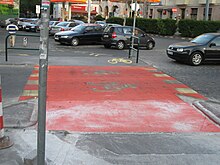Cyclist crossing

A cyclist crossing is a protective route for cyclists in Austria. The construct is used to regulate the right of way at places where the traffic routes of cyclists and other road users intersect at the same level, as well as the general indication of crossing cyclists.
In addition to the assigned signs, the design is also carried out by floor markings, by flashing yellow light signal systems and, more recently, by means of warning lights embedded in the floor along the cyclist crossing. If it is an unregulated intersection, in accordance with Section 68 (3a) of the StVO, cycle traffic may only approach at a maximum speed of 10 km / h and may not drive on it "immediately in front of an approaching vehicle and as a surprise for its driver". According to § 9 StVO, motor vehicle traffic has to enable a cyclist to “safely cross the lane if he is on the cyclist crossing or wants to use it in a recognizable way. For this purpose, the driver of such a vehicle may only approach a protective path at such a speed that he can stop the vehicle in front of the protective path and, if necessary, must stop in front of the protective path ”.
realization
The cyclists crossing similar in traffic law strongly the design protection path , marked both pure and at controlled by traffic lights points. Their labeling and the rules for driving or priority, but also parking in their vicinity, are very similar to this.
In terms of design, a distinction must be made between two variants, the transition at unregulated intersections (without traffic lights ), which are marked with a square, blue-framed sign to determine the applicable right of way , and the transition at regulated intersections, at the one pointing upwards triangular, red-framed sign, the presence of the cycle path crossing can be specifically pointed out or warned, while the right of way is determined by traffic lights, comparable facilities or signs regulating the right of way.
Traffic light crossings in particular often have crossings for pedestrians on all four sides, some of which are also combined with crossings for cyclists. People walking straight ahead and driving have priority over vehicles turning off. Because of the density of the existing guidance tools (traffic lights, signs, signposts ...), additional signs are usually no longer helpful due to the limited human receptivity, so often only white and red floor markings are attached to the crossing itself, and in some cases also Orange warning lights, some with applied symbols for the specific danger.
Behavioral recommendations
Since intersection areas are always conflicting points, in practice all road users are advised to behave particularly carefully there. For example, on some websites, young cyclists are advised to approach cautiously, to look around from both sides and, if necessary, to wait in unregulated cases. If this is regulated, it is also advisable to reduce the speed, observe the traffic lights and pay special attention to other road users turning right.
Regulations in other countries
Notice of cyclist crossing in the Czech Republic
Warning of crossing cyclists in Poland
Warning signs pointing out cyclists are widespread in national traffic regulations.
Cyclist crossings in the unregulated form are currently more the exception than the rule, both in traffic law and in implementation. The legal and visual design differs. Corresponding regulations are known for the following countries with their respective national names:
Germany
The German road traffic regulations do not contain any regulations on cyclist crossings. If a cycle path runs alongside the road, it also has right of way on a priority road and is then marked with a cycle path ford . Additional traffic signs are only required if the cycle path is cleared in two directions. If an independent cycle path is to be given priority, it can with
are signposted. A cycle path ford can be marked.




